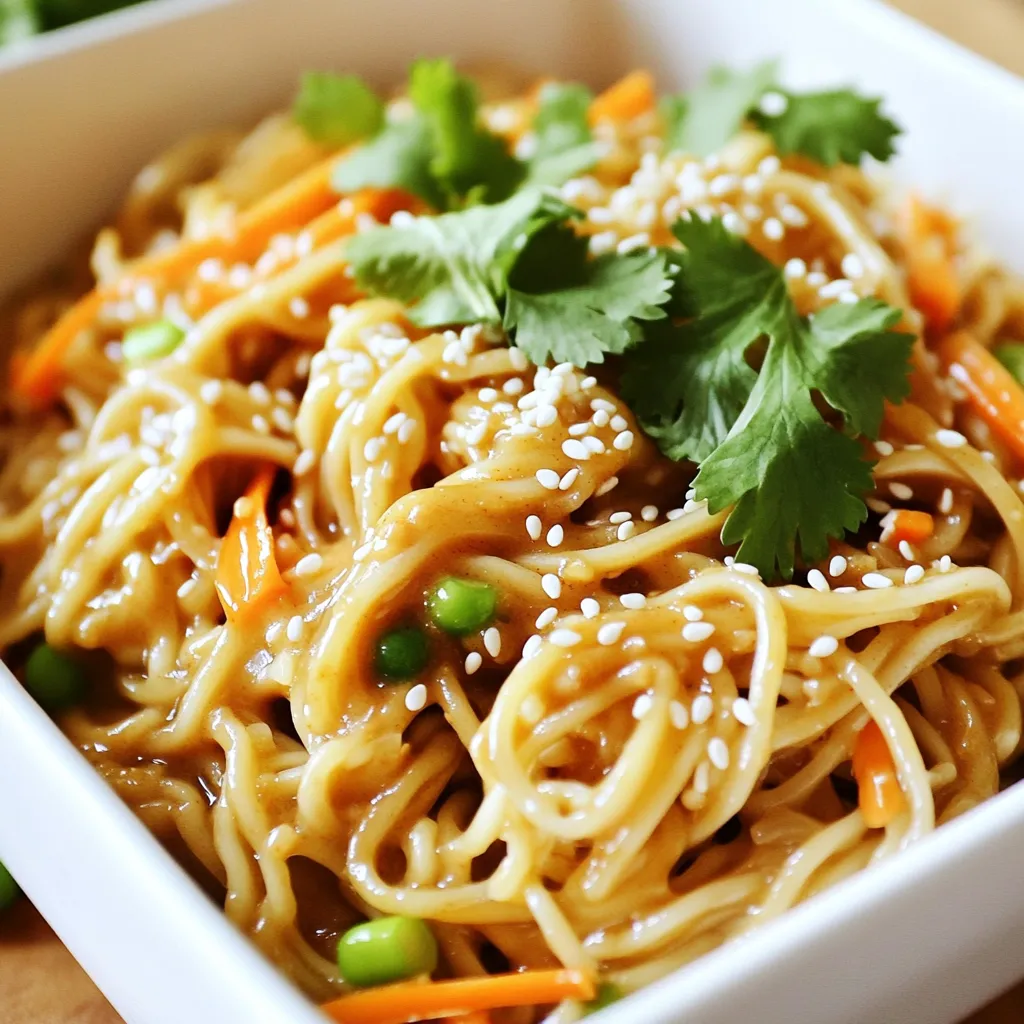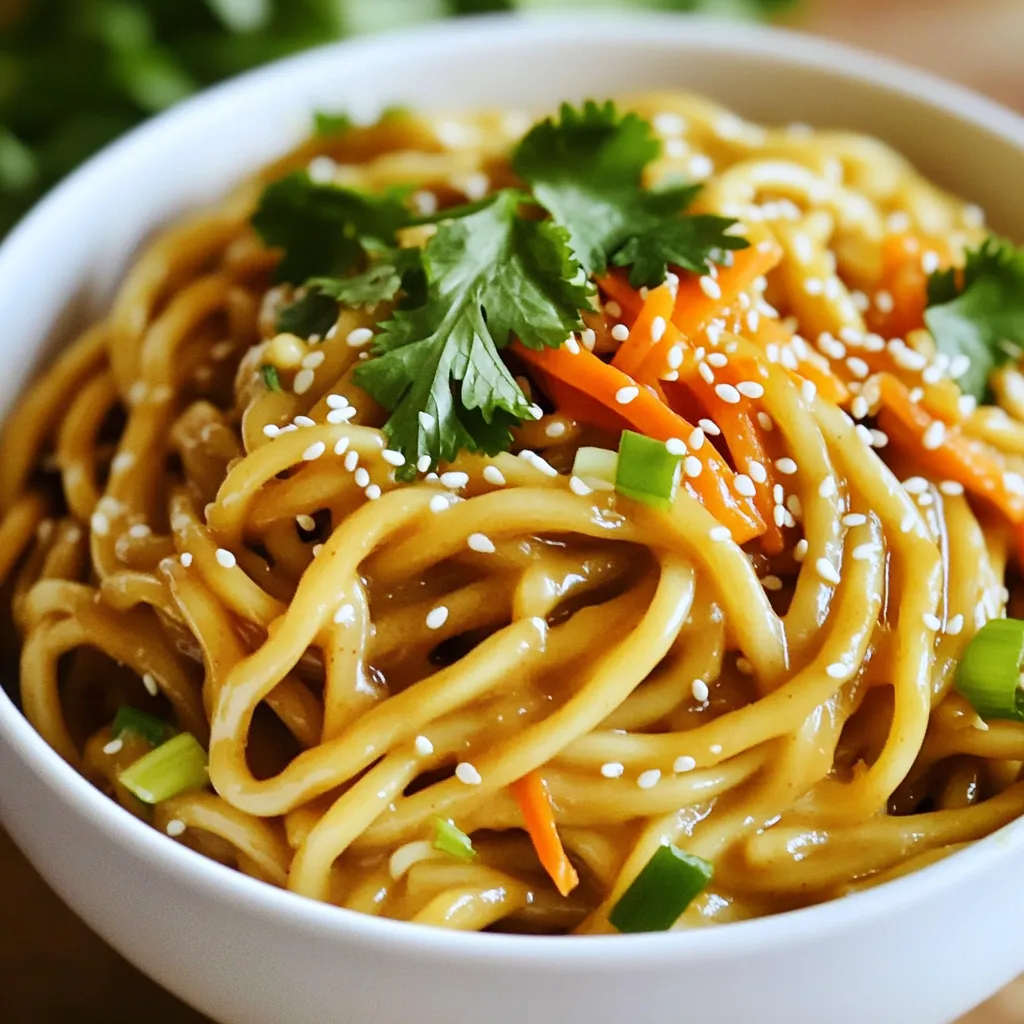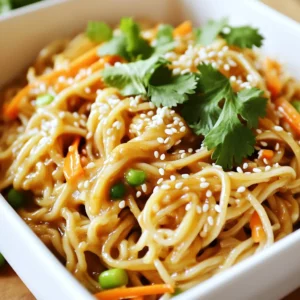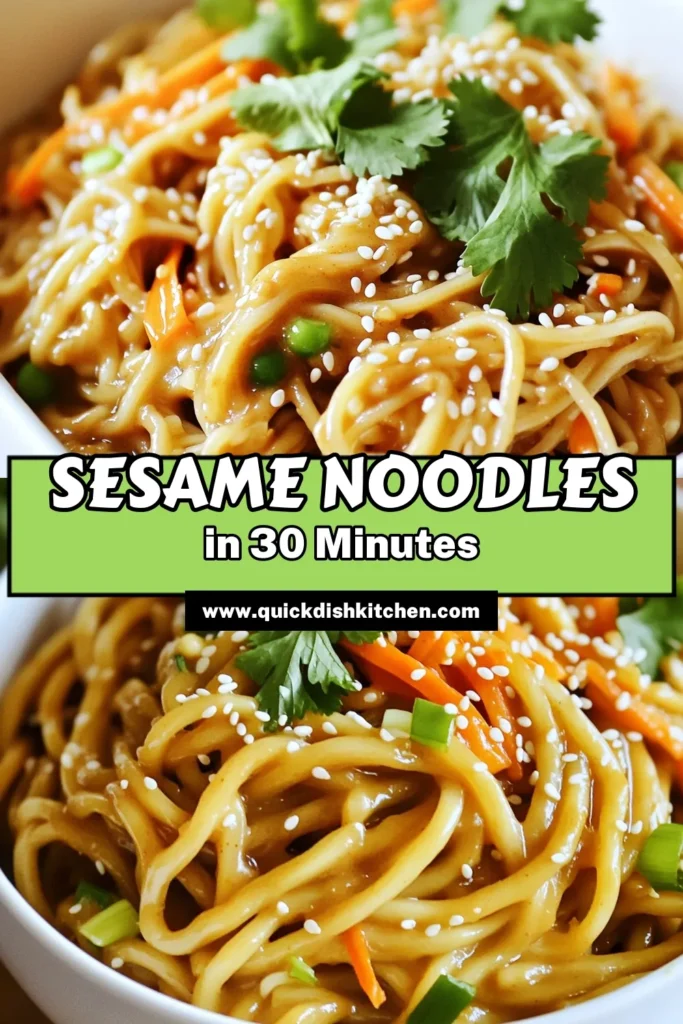Savor the taste of homemade sesame noodles, and say goodbye to takeout! With just a handful of ingredients, you can whip up a dish that’s easy, delicious, and far better than anything you’d get delivered. From the rich sesame oil to the perfect kick of ginger and garlic, this recipe has it all. Join me as we explore a simple way to elevate your dinner routine with enticing flavors you’ll love!

Ingredients
Main Ingredients
– 8 oz spaghetti or noodles of your choice
– 1/4 cup sesame oil
– 1/4 cup soy sauce
– 2 tablespoons rice vinegar
– 2 tablespoons honey or maple syrup
Flavor Enhancers
– 1 tablespoon fresh ginger, minced
– 2 cloves garlic, minced
– 1/4 teaspoon red pepper flakes
Garnishes and Extras
– 1/4 cup green onions, sliced
– 1/2 cup shredded carrots
– 2 tablespoons sesame seeds (for garnish)
– Fresh cilantro for garnish (optional)
In this easy recipe, I focus on simple, fresh ingredients. The combination of spaghetti or your favorite noodles with sesame oil creates a rich taste. I love using low-sodium soy sauce to keep it balanced. Rice vinegar adds a nice tang, while honey or maple syrup gives a hint of sweetness.
Fresh ginger and minced garlic bring depth to the flavor. I like to add red pepper flakes for a little heat. Adjust it as you wish for your taste.
For garnishes, green onions and shredded carrots add both color and crunch. Don’t forget sesame seeds for a nutty touch. If you enjoy cilantro, it makes a fresh addition too. These ingredients come together to make a dish that is better than takeout!
Step-by-Step Instructions
Cooking the Noodles
– Bring a large pot of salted water to a boil.
– Cook the spaghetti or noodles until al dente.
– Drain and rinse under cold water.
Cooking the noodles is the first step. The salted water helps to flavor the noodles. Al dente means the noodles will be firm but not hard. Rinsing them under cold water stops the cooking. This step helps keep the noodles from sticking together.
Preparing the Sauce
– Whisk together sesame oil, soy sauce, rice vinegar, honey or maple syrup, ginger, garlic, and peanut butter.
– Add red pepper flakes for heat.
Now, you prepare the sauce. Whisking the ingredients together creates a smooth mix. The sesame oil gives a nutty flavor, while soy sauce adds saltiness. Rice vinegar adds a bit of tang. Honey or maple syrup brings sweetness. The ginger and garlic add freshness. If you like spice, don’t forget the red pepper flakes!
Combining Ingredients
– Toss the cooked noodles in the sauce.
– Mix in green onions and shredded carrots.
– Let sit for 10 minutes to absorb flavors.
Next, toss the noodles in the sauce. Make sure every noodle gets coated. Then, add the green onions and carrots. They add color and crunch. Let everything sit for 10 minutes. This helps the noodles soak in all the great flavors. Now, you have a tasty dish ready to enjoy!
Tips & Tricks
Achieving Restaurant-Quality Flavor
– Use low-sodium soy sauce for balance. This choice keeps the dish tasty without being too salty.
– Let the noodles sit for ten minutes after mixing. This step helps them soak up all the good flavors.
Cooking Tips
– Stir the noodles well to coat them evenly with the sauce. This ensures every bite is full of flavor.
– Adjust cooking time based on the type of noodles you use. Different noodles cook at different rates.
Presentation Tips
– Garnish the dish with sesame seeds and fresh cilantro. These add a nice touch and make it look great.
– Serve the noodles warm or at room temperature. Both options taste amazing and are easy to enjoy.

Variations
Protein Additions
Looking to change up your sesame noodles? You can add grilled chicken or tofu for a protein boost. Grilled chicken gives a smoky flavor. Tofu makes it plant-based and light. You can also add shrimp for a seafood twist. Just cook the shrimp until they turn pink and toss them in!
Vegetable Variations
Want more crunch in your dish? Try bell peppers and snap peas. They add color and texture. Cucumber is also a great choice; it keeps things fresh. Broccoli can work well too. Just steam it lightly before adding to the noodles.
Flavor Enhancements
For a richer taste, use different nut butters like almond or cashew. Each brings its unique flavor profile. You can also squeeze lime juice into the mix. This adds a nice citrusy twist that brightens the dish.
Storage Info
Storing Leftovers
After enjoying your sesame noodles, let them cool completely. This step stops the cooking process. Storing hot noodles can lead to sogginess. Place the cooled noodles in air-tight containers. This keeps them fresh and tasty. You can store them in the fridge for up to three days.
Reheating Instructions
To reheat, I recommend using a skillet. Add a splash of water to help steam the noodles. Stir gently until heated through. If you’re in a hurry, you can use the microwave. Cover the noodles with a damp paper towel. This keeps the moisture in and prevents drying out. Heat in short intervals, checking often.
Freezing Advice
I do not recommend freezing sesame noodles for long-term storage. Freezing can change the texture and flavor. If you must freeze them, eat within a few days for the best quality. Enjoy your noodles fresh for the best taste!
FAQs
Can I use gluten-free noodles for this recipe?
Yes, gluten-free spaghetti or rice noodles work well. They give the same tasty flavor. Many brands offer great options. They cook just like regular noodles. You can enjoy this dish gluten-free with no problem.
How can I make this dish spicier?
Increase red pepper flakes or add sriracha to taste. Start with a little spice. You can always add more if needed. Mix in the heat until it feels right for you. This way, you can make it your own!
What can I serve with sesame noodles?
Pair with salad, spring rolls, or grilled meats for a complete meal. A fresh salad adds crunch and brightness. Spring rolls bring a tasty bite. Grilled meats offer protein and flavor. These sides make your meal feel special!
This blog post covered how to make delicious sesame noodles. You learned about the main ingredients and flavor enhancers that will boost taste. I shared step-by-step instructions to guide you through cooking. Tips and tricks were included to help achieve a restaurant-quality dish. You can even modify the recipe with proteins and vegetables to fit your taste.
Remember, these noodles shine best when served fresh. Enjoy making this dish and delighting your family and friends!


